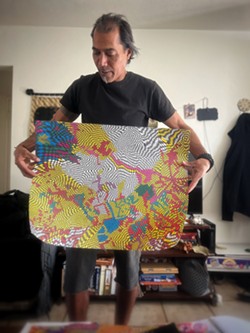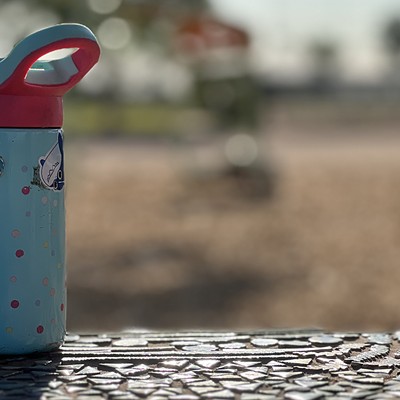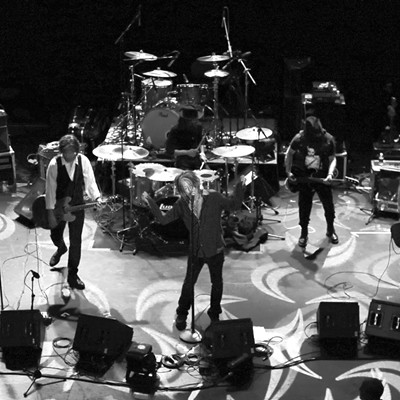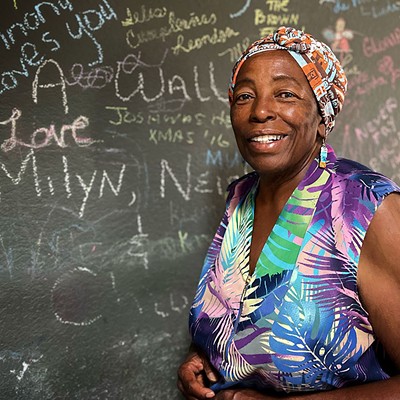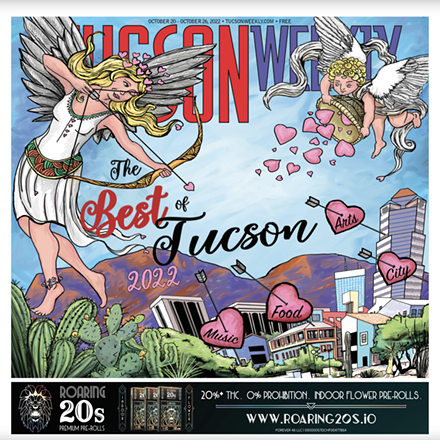In all manner of humanity. The motherly gaits and ‘Nam vets, the floral sun hats and deviant tats, the thick, the slight, the white, brown and black. And try, apply or taste: Organic soaps, desert-specific allergy stoppers and local-farm asparagus, and so on. Under a decorative race-horse-and-jockey silhouette perched high on a pavilion, this Tucson farmers market is stoked in the springtime heat.
Somewhere amidst the proliferate rows of booth vendors and sun-venerating shoppers, and with no fanfare, not even a sign or business card, Romny Guillen stands behind a portable folding table, lithesome, an extensive grin and benign eyes under a straw guardian hat, a wrist wrapped in Mala prayer beads. He talks to anyone.
There is a quiet authority about him, suggests otherworldliness, buffers the noisy flow. English is his second language after Spanish and when he speaks his voice lifts to a certain volume and never exceeds it. His table brims with trimmings of Arizona trees — mesquite, ash, chokecherry, etc. — hand-carved into spoons, forks and knives.
Folks stop and shell $15 for a wooden cooking utensil, a steal considering it took him years scraping, chiseling, layering and sanding, of diligence and craft, to perfect this precise skill.
The table centerpiece is a chuck of mesquite, the size of something a child could sit on. River-like swirls of tiny turquoise stones set in epoxy resin make it an alchemical dream of a thing, hand sanded and oiled, like some beautiful, aerial photorealist take of a rainforest.
Sprinkled about the table are little eyes out to the world, old bottle caps fitted with antique marbles and disparate finds like seashells and turquoise.
There is a calming beauty to this artist’s work, and folks who approach his table today sense a real deal. He enthuses of wood in a studious torrent of types, colors, strengths and aesthetics and they inspect his hand-carved one-of-a-kindness work in awe. A foot-shaped fork of mesquite, a spoon tiny as a fingernail.
He explains using his hands over electric tools, no different from his drawings and other art. “How I like to do things. I could make a hundred of these spoons a day with electric tools, power tools. But it takes me out of the zone.” His eyes squint in the sun, he laughs, adds, “Anyway, they’re just so noisy and I don’t like to carry around heavy tools.”
Someone will request a custom object, a wooden hairclip, for example, and Romny shakes his head. “It throws me off. So, I don’t really do that.” He doesn’t promote his work, either, zero social media. “I used to have Etsy and Facebook,” he said, shrugged, “I just don’t do that anymore.”
It stands to reason. He could sell a lot of his work. Today he’ll earn $300. Instead, he earns a living helping others through his art, and the art itself is his way to find calm in the world.
***
Romny was born into an impoverished childhood, grew up in the developing Dominican Republic. He likes to talk about its people, the animals, the trees, the way the sun felt, how it relates to a spirituality he tuned into as a kid.
He told of his mother hauling laundry to the river, dirt floors under feet, bumming 20-minute rides to dial a phone number. Surviving on food they could grow or pull out for roots, milk from animals, out on the grandparent’s rural farm. “For me, being a kid, it was like paradise, and there was food everywhere, fruit on the trees,” Romny said. “For my mom, not so much.”
He learned to build a fire, carve a hunted bird and cook it at age five. He learned to read young too, and was absorbed by the wilds of the outdoors, which turned creative, and soon he was drawing, building, and creating his own colorful kites.
Later, the family moved to the city, Santo Domingo. Still, he said, “we could count on the electricity going out every day.”
The alcoholic dad, who among other things (a teacher, a cop) became a star baseball player in a country mad for the sport. Sometimes he’d play drunk. He got out and traveled with a triple A team in America.
“He was a catcher, at the time one of the best players in the DR,” Romny said. Memories of his father are vague, a man floating in and out of the picture. “He lost all of his jobs because of his drinking,” Romny said. “But he was a very kind person.”
In the 1980s, souring economic conditions in the Dominican Republic saw immigration to the United States surge, Romny’s family part of it.
At 12, Romny arrived in the South Bronx, a Puerto Rican neighborhood, then a woebegone land of abject poverty, a ripe crack epidemic, all built on institutional racism. Romny remembers this 37 years later. His uncle and cousin collecting them at the airport and driving in. “I was looking at a skyscraper, thinking it would be nice to live in a building like that.” Oh, the excitement, the energy of a land of milk and honey, of opportunity, of sustenance and abundance. They kept driving, a cityscape growing progressively uninviting, until arriving on a street featuring gutted buildings, a burned down factory. The uncle stopped the car and said, “We’re here!”
“Oh, man,” Romny said. “And my school was at the end of the block.”
The family, mom, dad, sister, two brothers, couldn’t speak a lick of English, got by on Spanish. The family moved around a lot, lived in the projects once, parents found work in a textile factory.
Romny would go to sleep at night, hoping it was all a bad dream and he’d wake up in the morning back home. “I was coming from the farm, picking mangos and then landing in the Bronx.”
He’s almost shocked at his own recall. He got into fights, made friends, learned English, avoided gangs, steered clear of trouble. He said in his heart he really couldn’t hurt anyone or anything, and anyway, “once you live in the neighborhood they don’t mess with you.”
He bagged groceries, assisted a butcher and afforded a used car. He was considered an “at-risk” kid for a spell. After graduating from South Bronx High School, he was gone, looking to untangle things, his own oppression, the world around him, and his family, in all its love and drama. He pulled an open-road-as-inner-discovery Kerouac when pre-cellphone travel into the West was still exotic, risky. Sometimes he’d travel with a friend or friends, mostly alone. Blew his mind; he still thought the entire United States looked like the South Bronx. Sleep in his car, under a tarp in the wilds. “I went as far as Alaska.”
Eventually he found his way into North Carolina, near Asheville. An educational organization called Outward Bound, where, as a high school student, he’d earned a scholarship and spent a few summers. The outfit taps into the wilderness, rock climbing to canoeing, for personal growth. The very idea sidled up to his Caribbean Island boyhood, fueled his empathy for nature and living things. He discovered carving and wood sculpture. He was hired on as counselor, would save up and travel the offseason months. He stayed at Outward Bound for a decade.
He moved to Northern Arizona, which reminded him of the Dominican Republic in ways. He worked odd jobs including Barnes & Noble and Office Max (“that was the only job I ever walked out of”) to save enough to climb into his car and fire up “some creativity.”
In Flagstaff, he worked in a state juvenile detention center and the experience left him sad, jaded. He developed bonds with some of the kids, saw hard punishments and kid restraints that didn’t fit crimes. “The system is so out-of-whack, the money wasted. I needed a break to take care of myself.”
Self-care involved the Buddhist texts he’d long been into, Taoism, Zen, which he found far less judgmental and wrathful than the fear-motivating Catholicism of his youth. Because of the detention center experience, he figured he’d have to travel to Nepal or India to find a Buddhist temple. Instead, he found the Garchen Buddhist Institute an hour and a half from his Flagstaff home. He wound up staying there two years, inspired by the teachers and their central Tibetan Buddhism aspects, the visualizations, mantras, meditation for enlightenment. “Besides having faith, I was still struggling. Tibetan Buddhism was like coming home. And they weren’t asking me for money, I helped out, landscaping, whatever. I felt very welcome.”
***
I ask Romny to define what kind of artist he is and he returns a blank stare. Like, what?
His landscape photography, line art, carving, seems to be about capturing tender or oblique moments floating in the world around him, or pulling for his childhood. “I don’t know what to call it.”
Romny is an autodidact, “just figured everything out.” He took a few art and photography classes in high school. He once took a pottery art class at NAU in Flagstaff. “Got an A in that one,” he laughs.
Much of his work embraces a certain kind of abstraction, muddles any application of a narrative. Like the man himself, it is lighthearted with a moral earnestness.
Later he shows me a piece into which he’s got 40 hours invested. It is one of his many hand-drawn geometric works, shapes and tiny lines in marker pens that take on 3D effects. The 2- by 3-foot piece flies in the face of computer-generated AI, and tiny abstract imperfections allow emotion to slip through, works like a killer Charlie Parker live recording. It is deceptively elaborate. A finished piece is hypnotic, reveals something from nature, or a form of prayer and meditation. Get him talking, and he agrees, and tells of such prayers in wholly unironic ways; sometimes a shy laugh brackets the wholly personal assertion, as a kind of embarrassment sensor, as if what comes from his lips might sound incredulous or simple, as if praying for people to stop fighting or to be kind to one another is simple, or the lowly work of the meek. He is sincere and this is who he is. He meditates daily.
***
Romny began using his artistic skills to help those with developmental, intellectual, and physical disabilities. Worked on and off for seven years at the nonprofit Hozhoni Foundation, in Northern Arizona, caring for the elderly and the young with emotional problems, through art therapy.
He and his wife, Hilary Myla, moved to Tucson and he found similar work at another non-profit, Intermountain Centers for Human Development.
His art and work history helping others gets him hired in lieu of college degrees; he’s hired based on his abilities. To hear him say it, he’s almost shocked for the employment, alongside those with art degrees. Just doesn’t see what others see.
He is just now working at Resilient Health as an “artistic behavioral health specialist” under the center’s “Art Awakenings” purview. It favors his strengths, he said, a healing power of self-expression. He talks of one day returning to school to become an actual therapist. “It would be nice to get a little more scholarly.”
He talks of the suffering he’s worked with over the years, the schizophrenics, the suicidal, the bipolar, the disabled, the self-harming. Sometimes feeding and cleaning them.
“I present art as a coping skill, for the anger, isolation, loneliness. We can create something wherever we are. Sometimes a kid, who couldn’t be trusted with a plastic spoon, is soon carving safely with a small machete. It’s baby steps.”
He shakes his head, withholds specific horror stories of the severely troubled he’s seen and worked with, and said, “It taught me patience.” He pauses, considers that a moment, adds, “it’s pretty incredible to be able to share things I do to help them.”
***
Several days later, late-morning, Romny slackens into a chair on the small back porch of the midtown duplex he shares with his wife, who he met years ago at Outward Bound. “When I first saw her I knew she was it,” he said. “For her I think it took a little bit,” he laughs. Hilary is out today, doing office work at a local Montessori school. They’ve been married 15 years.
She’s not into Buddhism, and Romny said it doesn’t matter. “The amount of compassion that Hilary has comes naturally. Sometimes I wish I had that.”
Their place sits behind a new weed dispensary, which forced the landlord to erect a corrugated large metal wall around the property. The outdoor brick toolshed doubles as a meditation space, a sizable toolbox shares space with a Buddha and an Asian rug. A hummingbird hovers around blooms of tended cactus, colorful Tibetan prayer flags catch a light breeze over the pleasing yard, rich in springtime scents.
Romney talks family; the closeness with his sibs, who live in the northeast, and his mother, who still doesn’t speak English. His dad died a decade or so ago, Romny made it back to the Bronx in time to say goodbye.
The yard shows a shaded worktable to the side, with its forever patina of desert dust, organized with file tools, a small machete and raw pieces of wood. He sits anywhere with a sketchpad. He plays disc golf as a hobby, but not video games, and “I don’t watch TV much. I’d rather be outside creating something.”
Gentleness is a quality and value that gets squashed and beaten down daily in anyone worth a damn. As it is said, a good piece of wood has one major quality that defines it.
“I think I just want to be at peace,” Romny said. “Be here in the world, be OK.” He laughs, “then my mind goes all over the place.”
Brian Smith's collection of essays and stories, Tucson Salvage: Tales and Recollections of La Frontera, based on this column, is available now worldwide on Eyewear Press UK. Buy the collection in Tucson at Antigone Books, 411 N. Fourth Ave. You can also pickup his collection of short stories, Spent Saints (Ridgeway Press).



